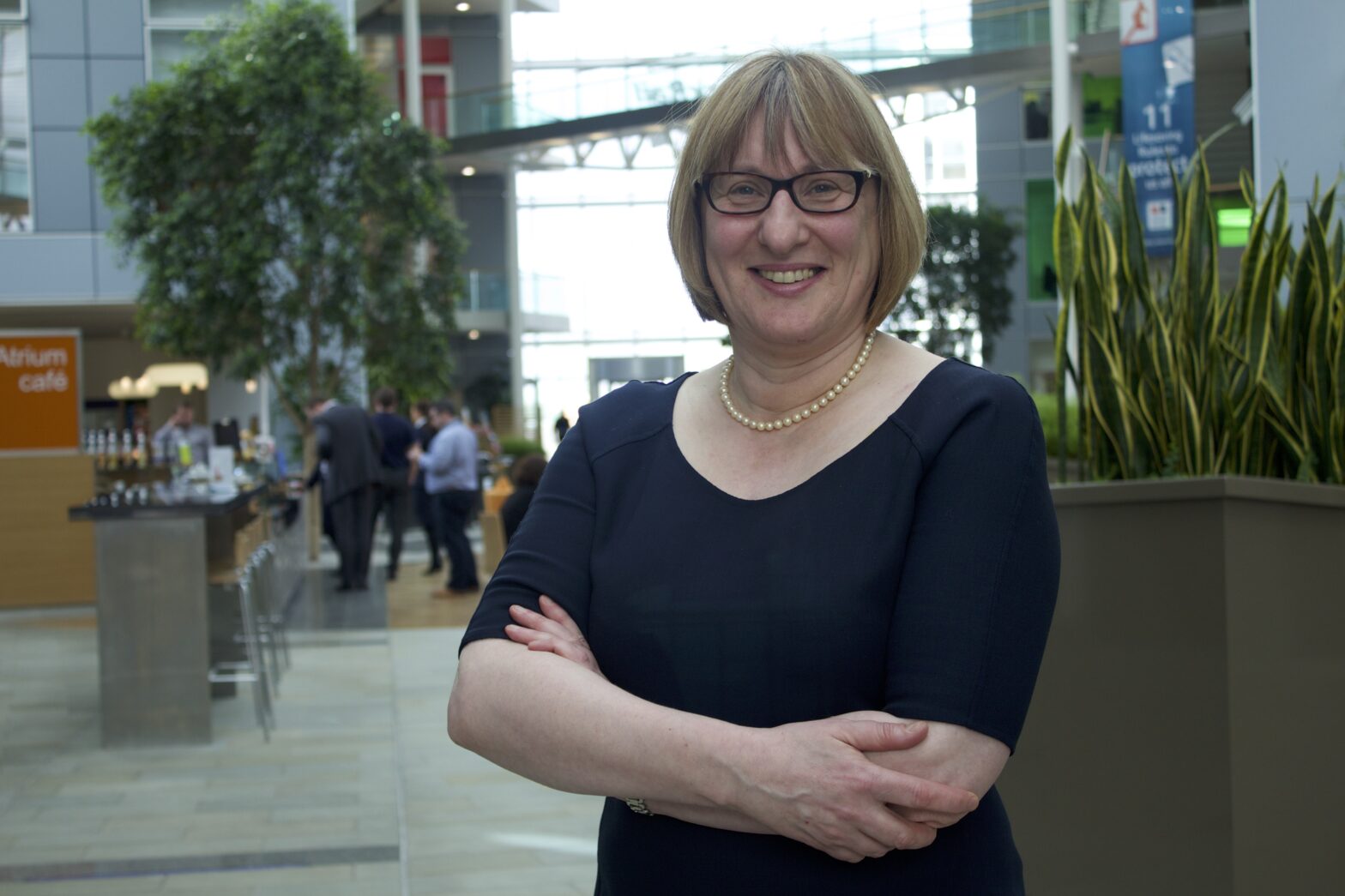Susan Cooklin is a tad flustered. Our March cover interview has been interrupted for the second time by a call she can’t ignore. CIO of Network Rail is not an easy job.
Each day, 24,500 trains, including 21,000 passenger trains, run on Britain’s railways, and Network Rail owns and operates the nation’s rail infrastructure, including the tracks, bridges and signal boxes.
 Yes, that means the organisation is often responsible for your train being delayed. There is about a 70-30 split between Network Rail-attributed delays – like a signal failure – and train-attributed delays.
Yes, that means the organisation is often responsible for your train being delayed. There is about a 70-30 split between Network Rail-attributed delays – like a signal failure – and train-attributed delays.
Add to that the 35,000 employees at the company, of which all are IT users since iPhones were given to the 12,000 maintenance workers, and that’s a massive pressure for the person tasked with heading technology.
But Cooklin rather enjoys the stress, she says with a cheeky smile as she returns from another emergency call.
God knows why. ‘If the information at Euston station is not on those boards, or it’s wrong, that is down to me,’ she says. ‘I will be screaming at somebody to fix something to get it back up again.’
Cooklin is passionate about her job, which is not unusual among technology leaders. What is unusual is that she’s a woman.
>See also: CIO Q&A – Susan Cooklin, Network Rail
A dire situation
For all the men in the industry who claim that the lack of women in IT is a non-issue, they’re wrong. And Cooklin is just as passionate about this as she is about keeping trains running.
‘Actually, things have got a lot worse in the past 15 years,’ she says. ‘Whereas back then something like a third of IT jobs were occupied by women, it’s now gone down to 17%, which is dire.’
There’s a big awareness drive needed, and Cooklin is keen to be a part of it. That’s why she invited teenage girls from across the country to take part in her ‘Could IT be you’ competition, sponsored by Network Rail.
Hundreds entered the competition, which Cooklin and her team whittled down to 70 for an assessment day at Network Rail’s headquarters in Milton Keynes in February. The winner, who will get her first-year tuition fees paid for, was announced on 10 March. Five runners-up will join the winner for two-weeks’ paid work experience in Network Rail’s IT department.
Cooklin hopes that this competition can play a part in showing young women the virtues of a career in IT, and that eventually the industry may see more female CIOs.
‘It’s a fantastic career for women because it’s something you can do part-time or full-time. You can dip in and out of it so long as you keep up to speed with trends, and it’s something that allows flexible working from home,’ she says. ‘It’s got all of those things around it that suit women very well.
‘I think what’s happened is that it’s become quite geeky over the past few years. I think part of it is perception, and part of it is that people think you need to have a degree in computing or engineering to do it.’
Cooklin has never experienced any misogyny in the industry, but that might just be due to her focus. ‘I’m the type of person who says: this is what I want and I’m going to go get it. I don’t think about whether people are sexist. When I was younger and heard people say that, it would irritate me hugely, but you’ve got to have people there to know that it can be done.’
It’s that attitude that has got her where she is, and it’s that determination that continues to drive innovation at Network Rail.
>See also: Network Rail drums up female interest in IT, announces competition winner
Billion-pound innovation
On 31 March, Network Rail publishes its Control Period 5 (CP5) delivery plans. In other words, it reveals how it’s going to spend its £38 billion budget over the next five years.
Cooklin has been given a hefty £1 billion for IT, and was tasked with pitching how that will be spent in the period up to March 2019 – quite a long time in the technology world.
Along with her senior team, Cooklin has spent the past couple of years putting together these plans. A total of £390 million is immediately devoted to keeping the operational service going, and once further costs are taken out, that leaves £525 million for capital expenditure and new projects.
Also, for the first time ever, Cooklin and her team were able to convince the regulator to provide a framework that allows them to go back for more if they have a worthy business case.
‘We’ve never had that before, so that’s fantastic,’ she says. ‘They acknowledged that it’s very hard to predict technology five years in advance – you don’t know what the solutions out there are going to be.’
So where will that money be spent? One big portfolio is the ORBIS programme, a £325m project to improve Network Rail’s approaches to the acquisition, storage and usage of asset information. The company is also investing in replacing some of the old systems that support freight, which Cooklin says have been poorly served.
Then there is the traffic management strategy, which involves the technology to support the phase-out of signal boxes and the creation of 14 regional operating centres across the country to concentrate control of the national network. The plan is to have 80% of the network controlled from the centres by 2029, with the remainder migrating by 2044.
‘That is a big, big programme that will improve the performance of trains and capacity on the railway, and it will allow us to close down some of the old systems,’ Cooklin says.
So it’s easy to see that the investment in technology at Network Rail is significant. The internal IT team of 550 is very large when you consider that only the hub desk, application support and strategy are in-house, while project delivery and the running of the service is outsourced to Atos (mainframe) and CSC (enterprise resource platform and some operating systems).
Furthermore, Network Rail has just changed its supplier on desktop break/fix from SCC to Computacenter, which picks up the contract from 1 April. The company’s framework agreement for IT projects is worth a considerable £360 million, which is tied up with five big suppliers (Accenture, BAE Systems Detica, Cognizant, CSC and TCS).
‘I favour the outsourcing model for where we are,’ Cooklin says. ‘I’ve worked in IT departments where you do it all yourselves and you have thousands of staff, like in a bank – but even the banks have outsourced a lot of that to third parties now.
‘Now, with cloud and everything, the barriers to entry are coming down because you can just buy what you want and focus on innovation.’
Network Rail’s experiences with cloud have so far been predominantly limited to the virtualisation of its servers, but Cooklin has plans to hook up with a third party to build the company a private cloud in the next couple of years.
>See also: Network Rail announces cut-down IT outsourcing supplier list
Intelligent thinking
With so many industry-specific solutions needed to continue to support Britain’s rail infrastructure, it’s inevitable that other projects can sometimes get pushed aside. Take the mammoth deployment of intelligent infrastructure as a key example.
‘It was all about trying to move us from just going out and fixing stuff on a regular basis to trying to predict and monitor what was going wrong on the tracks and then sending people out,’ Cooklin says. ‘So it was moving to a predict-and-prevent regime, rather than just find-and-fix, which is very expensive.’
Working with Thales UK, Network Rail placed controllers and monitors on the tracks that feed information to a system that allows maintenance workers to be sent out to fix an issue before it causes a train delay.
The first implementation went live about 18 months ago and, with more still rolling out across different sites, the technology is already estimated to have reduced delays for the travelling public and freight operators by hundreds of thousands of minutes.
The deployment of this centralised condition monitoring solution has elevated the UK’s rail infrastructure systems above those of its European counterparts, and has already proved to be a significant step forward in the sector.
As innovation like this continues to highlight the likes of Susan Cooklin as successful and inspiring women in IT, we can only hope that it will spawn a new generation of female technology leaders. And her ‘Could IT be you’ competition is certainly a great example of how the industry can raise awareness among young women as they choose their future career path.










